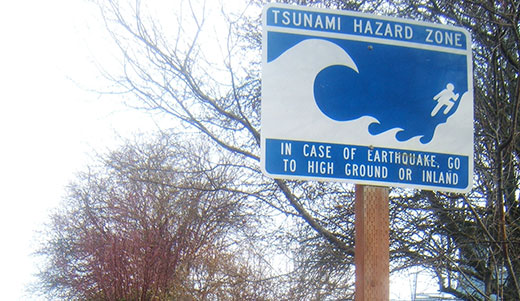
DUNGENESS, Wash. – Posted prominently beside the road leading out of this town at the mouth of the Dungeness River is a sign, “Tsunami Evacuation Route.”
My wife, Joyce, and I live on our family farm about one mile upriver from that sign. In the past we paid little attention to it and others like it.
But we are paying attention now. The human tragedy from the 8.9 Richter scale earthquake and tsunami that hit Japan Mar. 11 has brought home a truth we have all ignored. It could happen here.
Millions of people live in cities and rural communities near sea level in the states of Washington, Oregon and California. Like Japan’s east coast, the west coast of the United States is an active seismic region subject to sea floor earthquakes that could generate tsunamis like the one that destroyed Sendai and the surrounding towns and villages in Japan with an estimated death toll of 10,000.
Here in the Pacific Northwest the tsunami zone stretches for 600 miles along the eastern edge of the Juan de Fuca plate. It is grinding steadily under the North American plate in what geologists call the Cascadia Subduction Zone.
Ten years ago, the Nisqually earthquake erupted, inflicting serious damage to buildings in Seattle. It badly fractured the Capitol building in Olympia.
But what if the quake’s epicenter had been in the Pacific Ocean? Geologists studying core samples drilled into the sedimentary sandstone along the coast estimate that the Cascadia fault erupted 300 years ago, generating a 9.0 magnitude quake and a huge tsunami that engulfed the low-lying regions of the U.S. west coast and sped across the Pacific, destroying towns in Japan.
Tim Melbourne, an earthquake expert at Central Washington University, commented about last week’s quake and tsunami in Japan, “You have to be completely unaware not to look at this earthquake and ask yourself: What would Washington do if this was us? This is really an eye-opener.”
For my family and neighbors, the danger is real. A tsunami could surge up the Dungeness River flooding the broad alluvial plain where our farm sits. It is not unlike the fertile farmland that surrounds Sendai, Japan. Watching video scenes of the hideous tsunami engulf the lovely farmland, the picturesque towns, was heartrending but also a chilling reminder that it could happen to us.
Sunday’s Peninsula Daily News featured an opinion piece by New York Times columnist John Schwartz praising Japan for its advance planning, “with billions spent over the years on developing and deploying technologies to limit the damage from temblors and tsunamis.”
Those measures, he added, “almost certainly kept the death count lower than it might otherwise be – especially in comparison with the multitudes lost in recent earthquakes in China and Haiti.”
But what about our level of disaster planning? Just think the grim word “Katrina” and you know the woeful, even criminal, negligence of the U.S. government in failing to take measures to avert disasters and deal with the human tragedy afterward. The displaced people of New Orleans are still waiting for the promised money to rebuild their homes.
Dr. Irwin Redlener, director of the National Center for Disaster Preparedness at Columbia University, told the Times that the U.S. government seems “not have the ability or willingness” to prepare for “mega-disasters” like earthquakes, force-10 hurricanes, and tsunamis in the face of federal and state budget deficits.
That is certainly the mindset here in the Evergreen State. Gov. Christine Gregoire and the legislature are grappling with deficits now heading toward $6 billion. They seem to think they face a more immediate tsunami than the kind generated by an offshore earthquake, i.e., a tsunami of red ink that is forcing $2 billion in cutbacks to the state’s public schools, outright termination of the Basic Health program, and cuts in scores of other vital public services.
The root cause of this other tsunami is the corporate Republicans who bankrolled a campaign in last fall’s election to block every measure aimed at increasing tax revenues including I-1098, the Bill Gates Sr. “Tax the Rich” initiative to create a state income tax on those earning more than $200,000 annually.
That’s why we are riding the bus to Olympia, March 17, to demand that the legislature close billions in tax exemptions doled out to the banks and corporations to save our state. If they can’t muster the two-thirds majority needed to increase revenues, then put a referendum on the ballot next fall to close these exemptions. We will work to turn out the vote to get it passed. Some of the revenues can be used to prepare our state for a tsunami.
About 10 days ago, I was working in the garden when I heard a loudspeaker somewhere to the north blare a recorded message across the fields: “This is a test of the emergency warning system. This is only a test.” It was the first time ever I heard this PA announcement and I was indignant. The peace of a lovely spring day was interrupted. Less than a week later the tsunami hit Japan. I am no longer indignant. That PA system may save lives.
Photo: PW/Joyce Wheeler












Comments